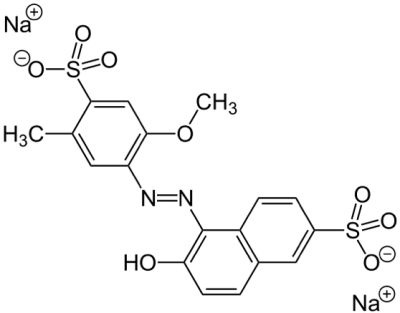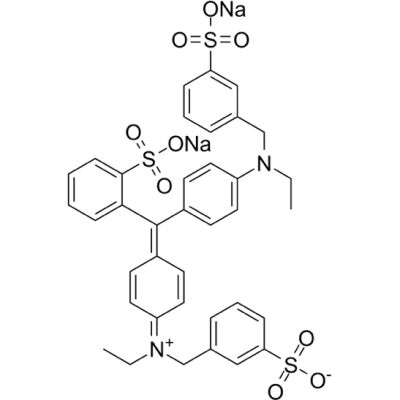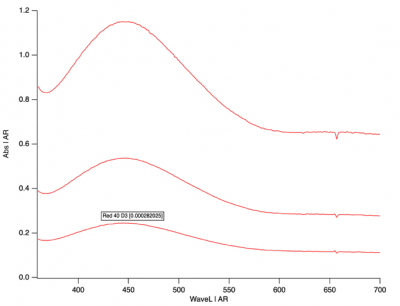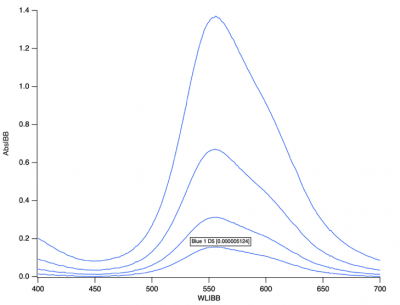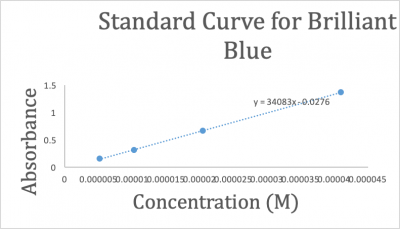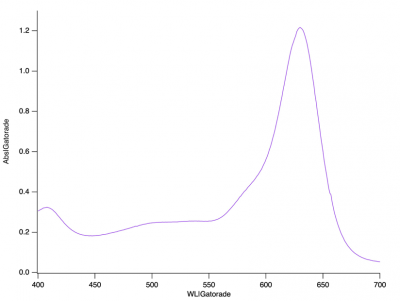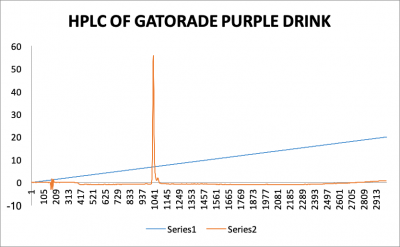Difference between revisions of "Final Research"
Justin2.1.0 (talk | contribs) |
Justin2.1.0 (talk | contribs) |
||
| (10 intermediate revisions by the same user not shown) | |||
| Line 6: | Line 6: | ||
Food dyes, synthesized originally from coal tar and now petroleum, have long been controversial. Many dyes have been banned because of their adverse effects on laboratory animals. Therefore, these food dyes might be hazardous in certain quantities to people, so it is imperative that these food dyes made by companies are always researched upon and analyzed to make sure that they are being consumed at the right concentrations inside foods that they are mixed with. Using the UV-Vis and the HPLC, analysis of food dyes and discovery of their components at particular concentrations becomes possible. Brilliant blue commonly known as food blue 1 or FD and C blue 1 is a synthetic blue dye that is used in foods, drugs and cosmetics and many more. Red 40 also known as Allura Red is a monoazo dye that is used widely in a range of food products and drinks to display different shades of red in the foods they are in. Blue 1, Red 40, Yellow 5, and Yellow 6 have long been known to cause allergic reactions in some people. CSPI says that while those reactions are not common, they can be serious and provide reason enough to ban those dyes. Furthermore, numerous studies have demonstrated that dyes cause hyperactivity in children. Being able to analyze the dye through the HPLC and the UV-Vis is therefore important and would be able to quantify its abundance in the consumable products that is found around us. | Food dyes, synthesized originally from coal tar and now petroleum, have long been controversial. Many dyes have been banned because of their adverse effects on laboratory animals. Therefore, these food dyes might be hazardous in certain quantities to people, so it is imperative that these food dyes made by companies are always researched upon and analyzed to make sure that they are being consumed at the right concentrations inside foods that they are mixed with. Using the UV-Vis and the HPLC, analysis of food dyes and discovery of their components at particular concentrations becomes possible. Brilliant blue commonly known as food blue 1 or FD and C blue 1 is a synthetic blue dye that is used in foods, drugs and cosmetics and many more. Red 40 also known as Allura Red is a monoazo dye that is used widely in a range of food products and drinks to display different shades of red in the foods they are in. Blue 1, Red 40, Yellow 5, and Yellow 6 have long been known to cause allergic reactions in some people. CSPI says that while those reactions are not common, they can be serious and provide reason enough to ban those dyes. Furthermore, numerous studies have demonstrated that dyes cause hyperactivity in children. Being able to analyze the dye through the HPLC and the UV-Vis is therefore important and would be able to quantify its abundance in the consumable products that is found around us. | ||
| + | |||
| + | [[File:AR.png|400px]] | ||
| + | |||
| + | Red 40 | ||
| + | |||
| + | [[File:bluebrilli.png|400px]] | ||
| + | |||
| + | Blue 1 | ||
==Experimental Methods== | ==Experimental Methods== | ||
| Line 18: | Line 26: | ||
{| class="wikitable" | {| class="wikitable" | ||
|- | |- | ||
| − | ! RED 40 !! | + | ! RED 40 !! !! |
|- | |- | ||
| − | | | + | | || Concentration || Absoption |
|- | |- | ||
| − | | Stock || | + | | Stock || 0.00225615 || 3.0721 |
|- | |- | ||
| − | | Dilution 1 || 0. | + | | Dilution 1 || 0.0011282 || 1.1509 |
|- | |- | ||
| − | | Dilution 2 || 0. | + | | Dilution 2 || 0.00056405 || 0.53712 |
|- | |- | ||
| − | | Dilution 3 | + | | Dilution 3 || 0.000282025 || 0.24504 |
| − | |||
| − | |||
|} | |} | ||
| Line 53: | Line 59: | ||
| Dilution 5 || 0.000005124 || 0.1558 | | Dilution 5 || 0.000005124 || 0.1558 | ||
|} | |} | ||
| + | |||
| + | [[File:Picture1.png|400px]] | ||
| + | |||
| + | '''Figure 1.''' Absorption maxima for Red 40 | ||
| + | |||
| + | |||
| + | [[File:Picture2.png|400px]] | ||
| + | |||
| + | '''Figure 2.''' Standard curve for Red 40 dye | ||
| + | |||
| + | |||
| + | [[File:Picture3.png|400px]] | ||
| + | |||
| + | '''Figure 3'''. Absorption maxima for Blue 1 | ||
| + | |||
| + | |||
| + | [[File:Picture4.png|400px]] | ||
| + | |||
| + | '''Figure 4'''. Standard curve for Blue 1 | ||
| + | |||
| + | |||
| + | [[File:Picture5.png|400px]] | ||
| + | |||
| + | '''Figure 5.''' Absorption maxima of Gatorade drink | ||
| + | |||
| + | |||
| + | [[File:Picture6.png|400px]] | ||
| + | |||
| + | '''Figure 6.''' HPLC Graph of Gatorade purple drink | ||
| + | |||
| + | |||
| + | Table I shows the data extracted from the graph in figure1 used to obtain the standard curve in figure 2 for Red 40. Table II also shows the data extracted from the graph in figure 3 used to make standard curve graph in figure 4. Although as seen in the graph that there are less points on both graphs for Red 40 and Blue 1, these were taken off to make an appropriate standard curve as measured absorption maxima above 1.5 in the UV/Vis would give a less accurate data in calculation for molar absorptivity. Figure 5 shows absorption maxima for the Gatorade drink and the first absorption maxima in that graph represents Red 40 appearing at around 415nm and the second maxima represents that of Blue 1 appearing at around 625nm. These graphs are seen to match the standards from the sample mixtures in previous graph figures showing that these compounds or components are actually present in the Gatorade drink. For better results, all of these samples were measured on the same day. Figure 6 shows the HPLC data collected for Gatorade purple drink and it is seen that only one component of the drink eluted. There is also a second line that cuts through the which could be that of the second dye but might not have been detected properly on the HPLC. | ||
| + | |||
| + | |||
| + | |||
| + | ==Summary== | ||
| + | |||
| + | The HPLC data was not as expected seeing that only one maxima showed up properly in the graph. This might have been from one of the dyes that since the HPLC data was taken on a different day than the UV/Vis spectra. In testing for the future, all samples must be tested on the same day for better results graphically and to keep conditions constant. | ||
| + | |||
| + | |||
| + | ==References== | ||
| + | |||
| + | [US Food and Drug Administration. Safety. FD&C Blue No. 1 (Blue 1) in enteral feeding solutions. Accessed 10/19/2011. http://www.fda.gov/Safety/MedWatch/SafetyInformation/SafetyAlertsforHumanMedicalProducts/ucm169530.htm | ||
| + | |||
| + | U.S. Food and Drug Administration. Color Additives: FDA's Regulatory Process and Historical Perspectives. Accessed 10/20/2011. http://www.fda.gov/ForIndustry/ColorAdditives/RegulatoryProcessHistoricalPerspectives/default.htm | ||
| + | |||
| + | Kenneth D. Ross. ''Reduction of Azo food dyes FD&C Red 2 (Amaranth) FD&C Red 40 by Thermally Degraded d-Fructose and D-Glucose''. J. Agrie. Food Chem., Vol. 23, No. 3. 1975 | ||
Latest revision as of 16:40, 15 December 2021
Abstract
Commercial food products contain dyes that have no nutritional benefit whatsoever and are just in these products to attract consumers. Analysis of a commercial drink Gatorade purple was tested for food dyes concentration of Blue 1 and Red 40. The resulting graphs showed proof of these dyes in the drink but full composition of the drink could not be obtained due to changing conditions.
Introduction
Food dyes, synthesized originally from coal tar and now petroleum, have long been controversial. Many dyes have been banned because of their adverse effects on laboratory animals. Therefore, these food dyes might be hazardous in certain quantities to people, so it is imperative that these food dyes made by companies are always researched upon and analyzed to make sure that they are being consumed at the right concentrations inside foods that they are mixed with. Using the UV-Vis and the HPLC, analysis of food dyes and discovery of their components at particular concentrations becomes possible. Brilliant blue commonly known as food blue 1 or FD and C blue 1 is a synthetic blue dye that is used in foods, drugs and cosmetics and many more. Red 40 also known as Allura Red is a monoazo dye that is used widely in a range of food products and drinks to display different shades of red in the foods they are in. Blue 1, Red 40, Yellow 5, and Yellow 6 have long been known to cause allergic reactions in some people. CSPI says that while those reactions are not common, they can be serious and provide reason enough to ban those dyes. Furthermore, numerous studies have demonstrated that dyes cause hyperactivity in children. Being able to analyze the dye through the HPLC and the UV-Vis is therefore important and would be able to quantify its abundance in the consumable products that is found around us.
Red 40
Blue 1
Experimental Methods
Stock solutions of Red 40 and Brilliant Blue 1 were made to concentrations of approximately 10-4M using distilled deionized water and the water was pipetted into the dye powder for accurate measurements of water dilutions. Dye concentration in food product was calculated from making standard curves for both food dyes and to find the molar absorptivity coefficients of each food dye of Red 40 and Blue 1. Solution of food dye to be analyzed was obtained from local shopping market and was not diluted since it did not look too concentrated in color. In making a standard curve for both dyes the UV/Vis instrumentation was used to collect all different dilutions from stock solution of both dyes Red 40 and Blue 1. Dilutions from stock solutions were made by halving each previous solution using serial dilution calculations. These were done to both of the stock solution of dyes until there were at least three dilutions from the stock solution prepared. The following molar masses were used for Red 40 and Blue 1 respectively; 496.42g/mol and 792.85g/mol. All of these samples were measured in the UV/Vis against water to obtain absorption maxima of the different concentration of mixtures.
Results And Discussion
Table I. Sample solutions prepared with respective concentrations and absorption maxima for Red 40 Red 40
| RED 40 | ||
|---|---|---|
| Concentration | Absoption | |
| Stock | 0.00225615 | 3.0721 |
| Dilution 1 | 0.0011282 | 1.1509 |
| Dilution 2 | 0.00056405 | 0.53712 |
| Dilution 3 | 0.000282025 | 0.24504 |
Table II. Sample solutions prepared with respective concentrations and absorption maxima for Blue 1.
| Blue 1 | Header text | Header text |
|---|---|---|
| Concentration (M) | Absorption | |
| Stock | 0.00016397 | 3.0721 |
| Dilution 1 | 0.000081983 | 2.764 |
| Dilution 2 | 0.000081983 | 1.3715 |
| Dilution 3 | 0.000020496 | 0.66959 |
| Dilution 4 | 0.000010248 | 0.31248 |
| Dilution 5 | 0.000005124 | 0.1558 |
Figure 1. Absorption maxima for Red 40
Figure 2. Standard curve for Red 40 dye
Figure 3. Absorption maxima for Blue 1
Figure 4. Standard curve for Blue 1
Figure 5. Absorption maxima of Gatorade drink
Figure 6. HPLC Graph of Gatorade purple drink
Table I shows the data extracted from the graph in figure1 used to obtain the standard curve in figure 2 for Red 40. Table II also shows the data extracted from the graph in figure 3 used to make standard curve graph in figure 4. Although as seen in the graph that there are less points on both graphs for Red 40 and Blue 1, these were taken off to make an appropriate standard curve as measured absorption maxima above 1.5 in the UV/Vis would give a less accurate data in calculation for molar absorptivity. Figure 5 shows absorption maxima for the Gatorade drink and the first absorption maxima in that graph represents Red 40 appearing at around 415nm and the second maxima represents that of Blue 1 appearing at around 625nm. These graphs are seen to match the standards from the sample mixtures in previous graph figures showing that these compounds or components are actually present in the Gatorade drink. For better results, all of these samples were measured on the same day. Figure 6 shows the HPLC data collected for Gatorade purple drink and it is seen that only one component of the drink eluted. There is also a second line that cuts through the which could be that of the second dye but might not have been detected properly on the HPLC.
Summary
The HPLC data was not as expected seeing that only one maxima showed up properly in the graph. This might have been from one of the dyes that since the HPLC data was taken on a different day than the UV/Vis spectra. In testing for the future, all samples must be tested on the same day for better results graphically and to keep conditions constant.
References
[US Food and Drug Administration. Safety. FD&C Blue No. 1 (Blue 1) in enteral feeding solutions. Accessed 10/19/2011. http://www.fda.gov/Safety/MedWatch/SafetyInformation/SafetyAlertsforHumanMedicalProducts/ucm169530.htm
U.S. Food and Drug Administration. Color Additives: FDA's Regulatory Process and Historical Perspectives. Accessed 10/20/2011. http://www.fda.gov/ForIndustry/ColorAdditives/RegulatoryProcessHistoricalPerspectives/default.htm
Kenneth D. Ross. Reduction of Azo food dyes FD&C Red 2 (Amaranth) FD&C Red 40 by Thermally Degraded d-Fructose and D-Glucose. J. Agrie. Food Chem., Vol. 23, No. 3. 1975
